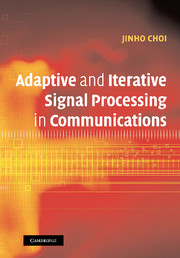Book contents
- Frontmatter
- Contents
- List of figures
- List of tables
- Preface
- List of symbols
- List of abbreviations
- 1 Introduction
- I ISI channels and adaptive signal processing
- 2 Channel equalization for dispersive channels
- 3 Sequence detection with adaptive channel estimation
- 4 Estimation and detection for fading multipath channels
- II Iterative signal processing for ISI channels
- III Other interference-limited systems
- Appendix 1 Review of signal processing and the Ƶ-transform
- Appendix 2 Important properties of matrices and vectors
- Appendix 3 Background for probability and statistics
- References
- Index
2 - Channel equalization for dispersive channels
Published online by Cambridge University Press: 23 November 2009
- Frontmatter
- Contents
- List of figures
- List of tables
- Preface
- List of symbols
- List of abbreviations
- 1 Introduction
- I ISI channels and adaptive signal processing
- 2 Channel equalization for dispersive channels
- 3 Sequence detection with adaptive channel estimation
- 4 Estimation and detection for fading multipath channels
- II Iterative signal processing for ISI channels
- III Other interference-limited systems
- Appendix 1 Review of signal processing and the Ƶ-transform
- Appendix 2 Important properties of matrices and vectors
- Appendix 3 Background for probability and statistics
- References
- Index
Summary
In this chapter, we study the intersymbol interference channel. Intersymbol interference (ISI) is a self-noise introduced by a dispersive channel. Since the ISI channel can significantly degrade the performance of communication systems, we need to mitigate the ISI. One of the methods that can achieve this is channel equalization.
There are two different structures for channel equalization. Linear equalization is based on a linear filtering approach. Since an ISI channel can be seen as a linear filter, a linear equalizer at the receiver equalizes the frequency response of the ISI channel to mitigate the ISI. The other approach is called decision feedback equalization, in which linear filtering and cancelation are used to alleviate the ISI. In addition to these approaches, which are based on the structure of the equalizer, the performance criterion is important in the optimization of an equalizer. Two of the most popular criteria will be introduced in this chapter.
We also study adaptive equalizers with fundamental properties of adaptive algorithms. For a given ISI channel, an adaptive equalizer can adjust itself to achieve the optimum performance. Therefore, adaptive equalizers are important practically.
In this chapter, we assume that the reader is familiar with the fundamental concepts of signal processing, including convolution, linear filtering, and the sampling theorem. In addition, a working knowledge of probability and random processes is required.
ISI channels and the equalization problem
We will derive a model for the ISI channel in the discrete-time domain since most receiver operations are generally carried out with digital circuits or digital signal processors after sampling.
- Type
- Chapter
- Information
- Publisher: Cambridge University PressPrint publication year: 2006



